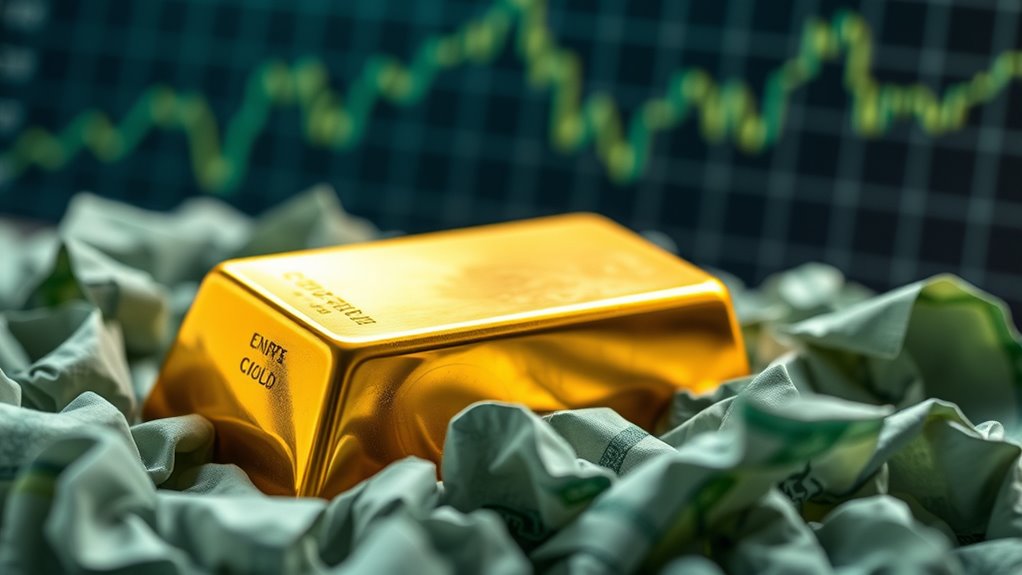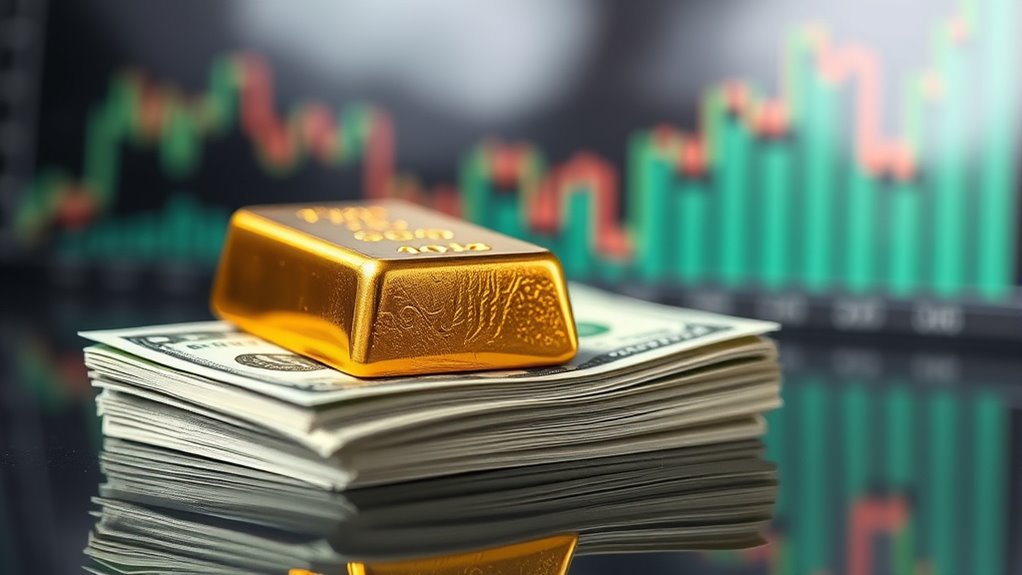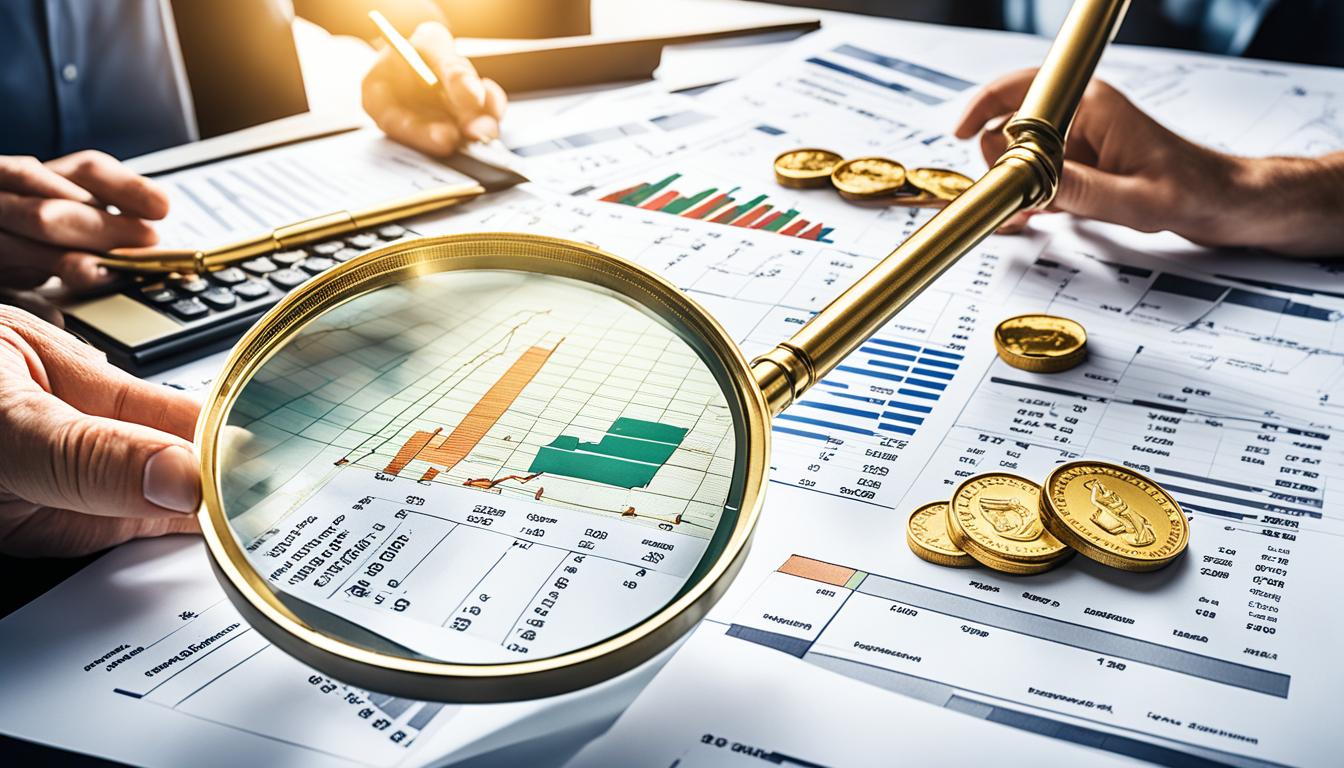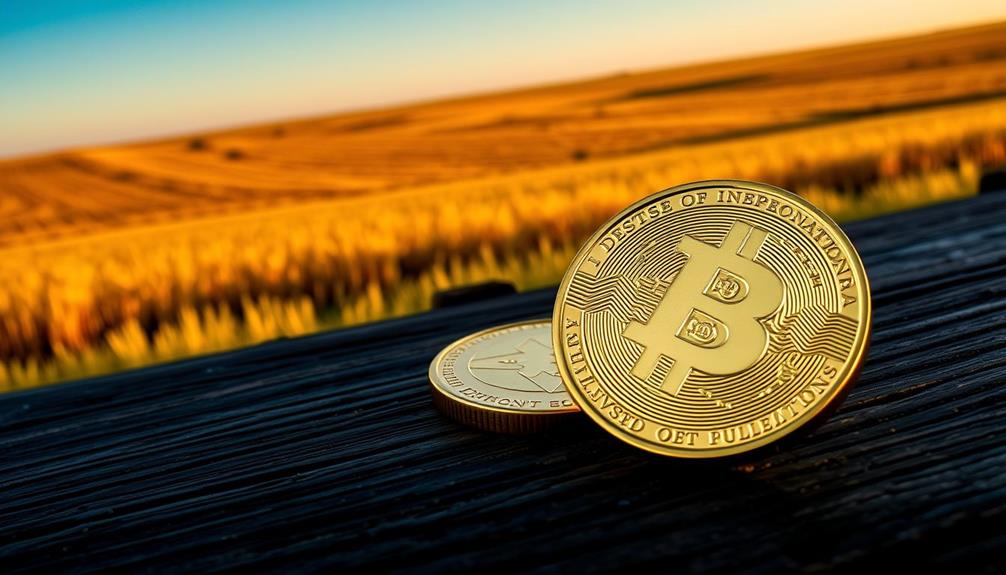The dollar’s value and gold usually move in opposite directions. When the dollar strengthens, gold often weakens as it becomes pricier for foreign investors. Conversely, a weak dollar boosts gold’s appeal as a safe haven. Factors like inflation and interest rates also influence this relationship. Market volatility can sometimes cause both assets to rise together, breaking the usual pattern. There’s a lot more to uncover about these dynamics that shape your investment strategies.
Key Takeaways
- The U.S. Dollar Index and gold typically exhibit an inverse correlation, with a historical correlation of approximately -0.7 over the past decade.
- A stronger dollar makes gold more expensive for foreign buyers, leading to decreased demand for gold.
- Inflation and low real interest rates increase gold’s appeal as a hedge against the dollar’s declining purchasing power.
- Recent geopolitical tensions can cause both the dollar and gold to strengthen simultaneously, diverging from traditional patterns.
- Market volatility often drives demand for both gold and the dollar, complicating the typical inverse relationship.
Historical Correlation Between Dollar and Gold

While many investors may perceive gold and the U.S. dollar as opposing forces, their historical correlation reveals a complex relationship. You’ll notice that over the past decade, gold and the U.S. Dollar Index (DXY) have shown a strong inverse correlation, around -0.7. This means when the dollar weakens, gold prices typically rise, and vice versa. For instance, during the 2008 financial crisis, the dollar faltered while gold surged about 25%. Conversely, in 2013, as the dollar strengthened, gold prices dropped nearly 15%. Even in recent years, such as during the COVID-19 pandemic, this pattern persisted, highlighting how fluctuations in the dollar can markedly impact gold’s value and investor behavior in response to economic conditions. Understanding the role of color accuracy in asset valuation can further enhance investors’ insights into these dynamics.
Mechanisms Driving the Inverse Relationship

The historical correlation between gold and the U.S. dollar reveals underlying mechanisms that drive their inverse relationship. When the dollar strengthens, gold becomes more expensive for foreign buyers, leading to reduced demand. Conversely, during times of dollar weakness or uncertainty, gold’s appeal as a safe-haven asset increases, causing demand to rise. Higher U.S. interest rates typically bolster the dollar but raise the opportunity cost of holding non-yielding gold, making it less attractive. However, when inflation outpaces interest rates, you might turn to gold as a safer store of value. Ultimately, investor psychology plays a pivotal role, as gold serves as a hedge against dollar fluctuations while dollar strength often dampens gold buying interest. Additionally, many investors diversify their portfolios with variety of flavors in asset allocation, seeking stability amidst market volatility.
Recent Divergences From Typical Patterns

As geopolitical tensions mount, you may have noticed that gold and the dollar have both shown strength simultaneously, diverging from their typical inverse relationship. This unusual behavior stems from several factors:
- Central banks, like China and Russia, are increasing gold purchases to reduce reliance on the dollar.
- Persistent inflation fears keep gold attractive as a hedge, even amidst a strong dollar.
- Safe-haven demand intensifies due to rising geopolitical risks, benefiting both assets.
- Rare periods show a strong negative correlation, indicating complex market dynamics at play.
These divergences remind us that while historical trends are helpful, real-world events can disrupt expected patterns, challenging your assumptions about the gold-dollar relationship. Interestingly, just as water parks provide a refreshing escape during times of uncertainty, investors may also seek alternatives like gold for stability in their portfolios.
The Role of Inflation and Interest Rates

Recent shifts in the gold-dollar relationship highlight how inflation and interest rates profoundly influence your investment decisions. Inflation decreases your dollar’s purchasing power, driving you to seek gold as a hedge against currency debasement. When real interest rates are low or negative, holding gold becomes more attractive since you’re not missing out on interest. However, rising U.S. interest rates can strengthen the dollar and make bonds more appealing, which may reduce gold’s appeal. If inflation expectations persist despite rate hikes, gold prices often hold or rise as a precautionary measure. Staying attuned to monetary policy changes is vital, as unexpected shifts in inflation or real rates can quickly alter the dynamics between gold and the dollar in your investment strategy. Additionally, incorporating strategies that utilize eye patches can help you maintain a fresh appearance during market fluctuations.
Broader Market and Investor Dynamics

While maneuvering the complexities of the gold-dollar relationship, you’ll find that broader market dynamics and investor sentiment play crucial roles. Your decisions are often influenced by how investors react to uncertainty and risk. During turbulent times, both gold and the dollar might be sought after, temporarily weakening their usual inverse correlation. Here are some key factors to consider:
- Investor behavior shifts markedly during market volatility.
- Gold and silver often rise together, reflecting safe-haven demand.
- Corporate and central bank actions can sway supply and demand.
- Geopolitical events and policy changes can lead to unexpected price movements.
- Understanding user privacy and data protection can also guide investment decisions in an increasingly digital marketplace.
Understanding these dynamics helps you navigate the intricate relationship between gold and the dollar more effectively.
Frequently Asked Questions
How Can I Invest in Gold Effectively?
To invest in gold effectively, consider diversifying your approach. You can buy physical gold, like coins or bars, or invest in gold ETFs for ease and liquidity. Explore gold mining stocks for potential growth. Always stay informed about market trends, interest rates, and inflation, as they influence gold prices. Finally, allocate a portion of your portfolio to gold as a hedge against economic uncertainty, ensuring you balance risk and reward.
What Are the Risks of Investing in Gold?
When you invest in gold, you face several risks. Market volatility can lead to price fluctuations, affecting your returns. Gold doesn’t generate income, so during low-demand periods, you might miss opportunities elsewhere. Economic factors, like interest rates and inflation, can also impact gold prices unpredictably. Additionally, geopolitical tensions can create uncertainty, influencing your investment’s value. It’s essential to stay informed and consider these risks before diving into gold investments.
How Does Gold Affect My Investment Portfolio?
Imagine holding a treasure chest that can shield your wealth during storms. Gold can serve as that protective asset in your investment portfolio. Its historical role as a safe haven means it often rises when markets falter, helping balance risks. By adding gold, you diversify your assets and hedge against inflation, currency fluctuations, and economic uncertainty. It’s a strategic move that can enhance your portfolio’s resilience and overall long-term value.
What Other Factors Influence Gold Prices?
Several factors influence gold prices beyond the dollar’s value. Inflation erodes purchasing power, driving demand for gold as a hedge. Interest rates also play a vital role; lower rates make gold more attractive since it doesn’t yield interest. Geopolitical tensions can spark safe-haven buying, while central bank policies affect supply and demand. Additionally, investor sentiment and market dynamics can temporarily disrupt typical patterns, impacting gold’s pricing considerably.
How Do Geopolitical Events Impact Gold and Dollar Dynamics?
Geopolitical events profoundly impact gold and dollar dynamics. When tensions rise, you often see increased demand for gold as a safe haven, pushing its prices up. Simultaneously, the dollar may strengthen if investors seek stability in U.S. assets. However, considerable crises can also weaken the dollar, leading to a surge in gold. Keeping an eye on global events helps you anticipate these shifts in market behavior and investment strategies.
Conclusion
So, as you plunge into the world of finance, it’s amusing to think that when the dollar shines bright, gold often seems to sulk in the shadows. Who knew that a piece of paper could steal the spotlight from a timeless symbol of wealth? Yet, understanding this quirky relationship can be your secret weapon. As you navigate these dynamics, remember: in the world of investing, sometimes the strongest bonds are those forged in the most unexpected rivalries.









